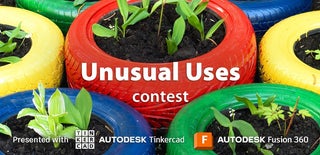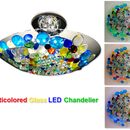Introduction: 🌼 DIY Seedling Propagator From Recycled Plastic Container 🌼
In this article, I will show you how to make a DIY seedling propagator from recycled plastic containers. This project is very easy to repeat and can be created from reused pieces.
Growing your own seedlings can be a rewarding experience, but it can also be challenging. One of the biggest challenges is providing the right conditions for germination. This is where a seedling propagator comes in. A seedling propagator is a small, enclosed container that creates a warm, humid environment that is ideal for germinating seeds.
Benefits of using a DIY seedling propagator:
- It is a cost-effective way to grow seedlings.
- It is a sustainable way to grow seedlings, as you can reuse the plastic containers.
- It is a versatile way to grow seedlings, as you can customize it to meet the needs of your plants.
The consumption of resources on our planet is growing every year. Therefore, if people recycled more old things and gave them a new life, this would have a positive impact on the overall state of the environment! Therefore, before throwing away something unnecessary, I always think about how to reuse it.
One of my hobbies is growing plants. If you have ever grown seedlings, you have probably come across the fact that there are never enough containers for them.
Growing healthy seedlings is not easy, especially when it comes to small plant seeds. With experience, new ideas come to improve and simplify the cultivation of seedlings. The idea to make a mini seedling propagator came to me after years of using disposable plastic containers.
Thick-walled food containers, such as those from ice cream, can be used for other purposes before being recycled.
Also, this mini greenhouse allows you to germinate seeds before planting them in the ground as seedlings.
The essence of this homemade product is to create the most favourable conditions for plant development. I was also interested in the possibility of reusing a mini greenhouse. Ordinary thin-walled food containers do not allow this (they are disposable).
💡 This tool can also be used for in vitro propagation.
Supplies
Materials:
✿ 1 plastic container (ice cream container): 195×125×85 mm;
✿ 1 plastic cover (transparent): d = 80-100 mm;
✿ 1 sleeve with fastening (aluminium or plastic) d = 4 mm;
✿ 1 LCD thermometer with a hygrometer;
✿ Seeds: tobacco (Nicotiana tabacum) or various vegetable seeds (optional);
✿ Soil: Professional propagation substrate SF 1 ("Sully floor") - 0.25 - 0.5kg .
Tools:
✿ drill machine & drill d = 4.2 mm;
✿ metal ruler, tape measure;
✿ soldering iron with a tip 1.5–2.5 mm;
✿ screwdriver;
✿ awl;
✿ mounting knife;
✿ calliper;
✿ marker;
✿ soil moisture meter, PH meter, sunlight 3 in 1 (optional).
Step 1: Container
To make holes in a plastic container, you can use a soldering iron. The holes can be made in any order, or you can pre-mark them into segments of certain sizes. I made about 70 holes, with a distance between them of 15 mm.
To make holes in the round plastic cover, you can use an awl. Then, use a screwdriver to drill holes that are 4.4 mm in diameter. Finally, use a knife blade to remove any remaining plastic.
Step 2: Cover
Use a marker to draw a circle of the desired diameter on the lid. The diameter of this circle will depend on the container you are using. Then, cut out this circle with a knife.
Mark a hole in the center of the plastic lid of the container with an awl and drill it.
Just like before, use the blade of a knife to remove any burrs. The blank circle for ventilation can be trimmed with scissors.
Place a circle on the lid of the container and use a marker to mark its dimensions.
Step 3: Ventilation Holes
Make an adjustable damper. The damper should be made of a material that is strong and durable, such as aluminum or plastic. It should also be adjustable so that you can open and close the ventilation holes as needed.
Mark the ventilation holes (4). Use a marker to mark the locations of the ventilation holes on the plastic circle blank. The number and size of the holes will depend on the size of the propagator and the needs of the plants you are growing.
Cut out the ventilation holes. Use a sharp knife or a metal ruler to cut out the ventilation holes. Be careful not to cut yourself.
Fasten the damper to the lid. You can use an aluminum rivet, a plastic sleeve, or another type of fastener to secure the damper to the lid of the propagator.
Step 4: Thermometer & Hygrometer
I inserted an electronic thermometer with a hygrometer into the lid of the propagator. This allows me to monitor the microclimate inside, so I can easily grow seedlings without exceeding the parameters for certain plant varieties.
First, I marked and cut out an opening for the thermometer in the lid of the container. The hole should be slightly smaller than the thermometer itself, so that it does not fall out.
Now, I can easily check the temperature and humidity inside the propagator and adjust the settings as needed.
Step 5: Seeds
A propagator can help seeds germinate much faster, even those that typically germinate slowly, such as pepper, eggplant, celery, sorrel, strawberries, dill, and parsley. This also applies to other crops, such as tomatoes, onions, and beets, which will sprout in a few days. Flower growers will find it invaluable, as seeds such as nirembergia, kobe flax, morning glory, and snapdragons can take up to 20 days to germinate, but a propagator can speed up this process.
Thanks to the propagator, you can create the perfect microclimate for your seeds, depending on their specific needs. You can use it indoors or outdoors, and it's a great way to test seed germination before planting. Simply place your seeds on a damp paper towel or napkin in a container with drainage holes, and the propagator will do the rest. It's like an incubator for seeds!
Step 6: Propagation Substrate
Before you start sowing seeds, you need to prepare the soil. You can use specially purchased potting soil for seedlings, or you can make your own. If you make your own, you can mix garden soil with other components, such as sand and peat. The proportions of these components will depend on the plants you are growing.
I tried different methods of preparing the soil, and I ultimately settled on using specially purchased potting soil for seedlings. I poured the soil into a container and lightly tamped it down with another container of the same type.
Although the purchased soil is already disinfected, it is still a good idea to disinfect it again with boiling water or another method.
After moistening the soil, I tamped it down again and added more soil if necessary.
It is important to calculate the amount of soil so that there is enough for the development of the plant's root system but also enough room on top for the formation of leaves.
Step 7: Temperature
A propagator can be made even more versatile by adding heating. To do this, you can add a third container below the other two and install an insulated heating wire. This will create a mini-heated greenhouse.
The lower container will need to be filled with an inert material, such as pebbles, sand, or other suitable materials, to store heat and insulate the heater. Depending on the heating cable used, this design can be supplemented with a thermostat.
You can also purchase special heated mats for seedlings or make your own from floor heaters. I would recommend using 12-volt heaters for safety. Alternating current at 110 and 220 volts can be fatal for both you and the plants due to the humidity and watering.
This type of heating may be appropriate if you do not have enough space near a heating radiator or if the radiator does not meet the temperature standards for seed germination.
In general, seeds need temperatures above 15-20 degrees Celsius to germinate quickly. For the tobacco crop that I grow, the seed germination temperature should be between 24 and 30 degrees Celsius. The germination temperature for other crops varies depending on the plant and variety.
Step 8: Watering Seedlings
I also noticed that many people neglect the proper watering of seedlings. First, seeds are planted in a pre-prepared, moist environment, such as soil. Further watering should be done by spraying water with a spray bottle, not with pipettes or syringes. Water must be disinfected by boiling or adding potassium permanganate or other substances. I use an eco-friendly infusion of onion peel, which has antifungal and antimicrobial properties and is also a bio-additive for normal plant germination. Watering is done by adding water to the lower container.
Step 9: Soil Drainage
By using two containers, one of which has a hole in the bottom, the soil can be drained. This allows excess water to accumulate in the lower container, preventing the seeds from rotting. Seedlings can then be watered by pouring water into the top container. This is an important point to remember, as it will help to regulate the growth of the seedlings and prevent mold growth.
In the first days after sowing, the propagator should be closed with a lid, and the ventilation openings should also be closed. This will help to create a humid and warm environment that is ideal for seed germination. Once the seedlings have sprouted, the lid can be opened slightly to allow more air to circulate. The temperature and humidity can also be reduced gradually.
Step 10: Test
The propagator is now ready. All that's left to do is add potting soil and sow the seeds. Place the container in a warm spot and wait for the seedlings to germinate.
For the first few days, keep the seeds warm and monitor the humidity and temperature levels. Gradually open the ventilation vents to ventilate the seedlings and prepare them for a normal room temperature. At night, be sure to close the lid of the container. This will help to harden the seedlings and prepare them for transplanting.
Step 11: Results & Advantages
I made this homemade propagator as a comprehensive solution for growing seedlings. It can be customized in the future by adding or changing structural elements, such as electrical heating. The container can be stacked, meaning that it can be closed on top of another container of the same type, allowing the plants to grow upward. With larger plastic containers, you can grow seedlings up to transplanting in large containers or in the ground.
It is advisable to choose a transparent plastic container of a suitable size with a transparent lid. However, I do not need a transparent lid because I move the seedlings to a mini greenhouse after a week of germination. The seedlings remain open in the greenhouse until transplanting.
Most seeds germinate without light, so they can germinate in the dark. The most important thing is to provide the right temperature and humidity for germination. Some seeds germinate in the shade or in the light, so this should be taken into account when planting.
It is also essential to remember that the root systems of plants should be protected from sunlight. This means that the container that holds the soil should be protected from light in the future.
In conclusion, a DIY seedling propagator made from recycled plastic containers is an excellent way to grow healthy seedlings. This project is simple and affordable, and the results are splendid.
💡 The propagator can also be applied to growing micro-plants for salads, etc.
Thanks for your time and attention to this topic! 🌼
Step 12: Video Demonstration
P.S. Additional videos for this and other projects can be viewed on my YouTube channel (see my profile).

Participated in the
Unusual Uses Contest













